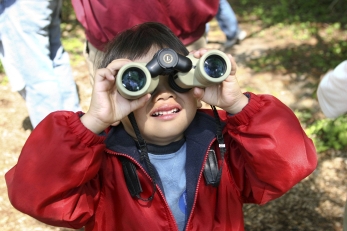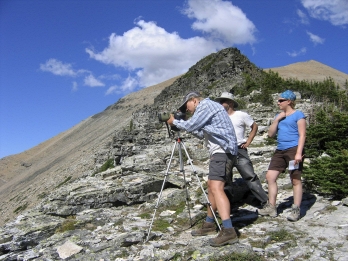OUTREACH
Citizen science group builds a field of study and buoys projects across the nation

Participants with binoculars in the annual Great Backyard Bird Count, one of Citizen Science Central's projects. See larger image
From projects on butterflies, pollen outbreaks and light pollution to mountain goats, Cornell's Citizen Science Central supports a growing network of citizen science projects around the country, offering resources and support to project leaders and inviting the public to post targeted observations.
For example, with an increasingly warmer climate, people around the world are monitoring monarch butterfly migration, the first calls of frogs and the budding and blooming of trees and flowers.
"Most of what we know about the impact of climate change on organisms comes from citizen science projects," says Rick Bonney, co-founder of the Citizen Science program at Cornell and director of program development and evaluation at the Cornell Lab of Ornithology.
The Citizen Science Central website aims to bring together experts across disciplines, building the field of citizen science and sharing best practices. The site also helps people design and implement volunteer monitoring projects. Researchers post their projects online, providing numerous examples of successful ongoing projects.

A young participant with binoculars in the annual Great Backyard Bird Count, one of Citizen Science Central's projects. See larger image
For example, the Lab of Ornithology sponsors many projects involving birds and collaborates with Ithaca's Sciencenter to get middle school students involved in monitoring. Through NestWatch, students record information including location, species of birds, the number of eggs laid and the number of birds that hatch from these eggs for each nest.
In citizen science projects at the lab like eBird and Project FeederWatch, volunteers record bird sightings and count the number of birds of varying species that come to a set location.
The Internet, Bonney notes, has allowed citizens to record their data directly on the Web. Filters built into the data entry system can double-check entries, and "advanced methodology helps ensure accurate data analysis, which requires a real understanding of complex data sets that result when you have thousands of people sending you information," Bonney says.
.
A citizen scientist searches for mountain goats in Glacier National Park. See larger image
Successful projects build upon activities or hobbies that people are already doing. Bonney explains, "When people are already collecting information about birds and keeping bird lists, it's not hard to get them to contribute that information to a database."
The website includes links to such projects as: Project BudBurst to monitor the appearance of buds in spring and other seasonal plant phases; operation Ruby Throat to observe the migratory behavior of hummingbirds; Monarch Watch to observe the migratory behavior of monarch butterflies; GLOBE at Night to monitor light pollution and its effects on various species; TemperatureBlast to promote climate change awareness, involving 12 science centers across the nation, including Ithaca's Sciencenter; and BioBlitzes, which organize and analyze data to help specialists with intensive biological surveys
Increasingly, smartphone apps will contribute immensely, Bonney notes, allowing new and innovative forms of data collection. "There are a lot of apps that are being built now by different groups and organizations to collect data, but a lot of the data are not going into databases yet."
If he has anything to say about it, that will change soon.
Citizen Science Central is supported by the National Science Foundation. Visit www.birds.cornell.edu/citscitoolkit/.